
ON Whey Protein vs Dymatize-ISO 100 - Difference in Blends?

Optimum Nutrition's Gold Standard is the most popular protein powder on Earth, while Dymatize's ISO 100 is the most popular hydrolyzed whey product on Earth. Both companies make products that compete with the other's - ON has a hydrolyzed whey, Dymatize has a whey blend - but these are the two products the companies are known for. If you're walking through a supplement store and comparing the two companies, these are the products you'll have in your hands.
The big difference is that Gold Standard is a blend of three kinds of whey whereas ISO 100 is primarily made with hydrolyzed whey. But there are a few other interesting things to note.
Optimum Nutrition Gold Standard Whey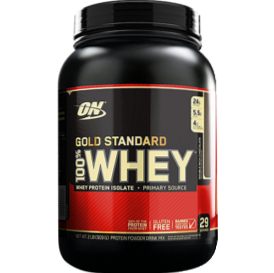
The market's most popular whey lives up to its reputation as a solid all-rounder with a huge variety of flavors to choose from. It includes 24 grams of protein in each round scoop and mixes well with milk or water.
Shop Amazon Dymatize Iso 100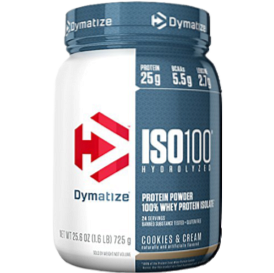
A protein powder comprised mostly of hydrolyzed whey, which may help you recover more quickly than other forms of whey.
Shop AmazonWhat Are the Different Types of Whey?
There are two types of protein in milk: whey and casein. The two are separated in the cheesemaking process and while whey used to be considered a waste byproduct, it turns out it can be turned into high protein powder. There are three main kinds of whey.
Whey concentrate: this is the simplest, least processed, and cheapest whey. It also contains the most lactose, sugar, carbs, and fat. You can expect about 3 or 4 grams of each for every 20 grams of protein.
Whey isolate: A little pricier, this has been processed so as to remove most, and sometimes all of the fat and carbs.
Hydrolyzed whey: Also called whey hydrolysate or whey peptides, this is whey that has had acids or enzymes added to it so that it's been broken down to the point that some consider it to be “pre digested.” This means it digests the fastest of the three types of whey; it's also very low in carbs and fat and the most expensive.(1)
So is hydrolyzed whey best? Maybe. The Journal of Science and Medicine in Sport published a study of 28 athletes that found when working out twice per day, those who took hydrolyzed whey recovered their power more quickly than those who were taking whey isolate.(2) So hydrolyzed whey seems to be better for high level athletes. If you're an average person working out a few times per week instead of a few times per day, it seems unlikely to make a practical difference.
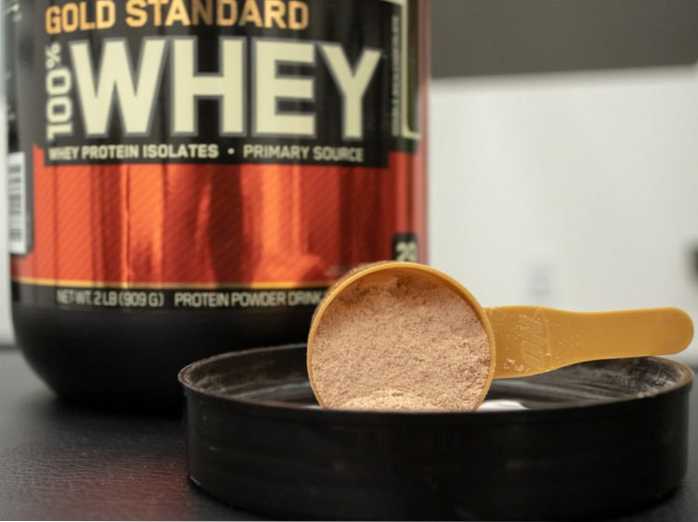
Nutrition
Optimum Nutrition Gold Standard
Both of these products have 120 calories per scoop, but the macros and micros are a little different. Here's what you'll get in Gold Standard.
Calories: 120
Protein: 24 grams
Carbs: 3 grams (1 gram of sugar)
Fat: 1 gram
Calcium: 8% of the recommended daily intake
Sodium: 5% of the RDI
Cholesterol: 10% of the RDI
[Check out our full review of Optimum Nutrition Gold Standard!]
Dymatize ISO 100
Calories: 120
Protein: 25 grams
Carbs: 2 grams (1 gram of sugar)
Fat: 0.5 grams
Calcium: 10% RDI
Sodium: 7% RDI
Cholesterol: 3% RDI
Given it's so much higher in hydrolyzed whey, it makes sense that ISO 100 has more protein and less fat and carbs than Gold Standard. The differences in calcium and sodium are negligible, though the significant difference in cholesterol may be a factor for some users. Given it's lower in cholesterol, higher in protein, and a tiny bit higher in calcium, the edge goes to Dymatize.
[Take a look at our full review of Dymatize ISO 100!]
Winner: Dymatize ISO 100
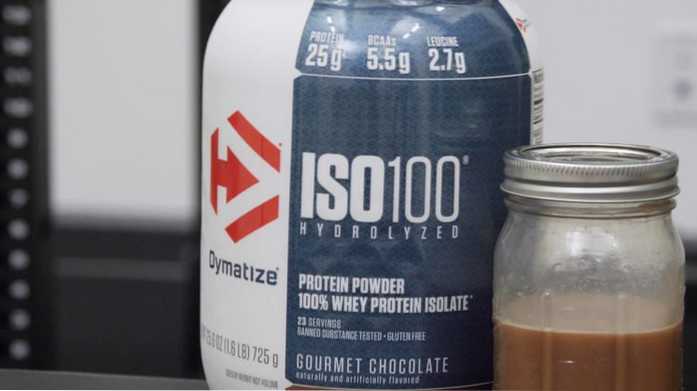
Ingredients
Optimum Nutrition Gold Standard
The biggest difference to note here is that Gold Standard is a blend of three types of whey: isolate, concentrate, and hydrolysate in that order.
The rest of the ingredients are soy lecithin (for mixability), natural and artificial flavors, the artificial sweetener acesulfame potassium, and the digestive enzymes Aminogen and lactase. These may help to reduce reduce digestive issues like flatulence that can arise from consuming lactose.
[Check out our best protein powder roundup]
Dymatize ISO 100
ISO 100's first ingredient is hydrolyzed whey and then whey isolate.
The other ingredients are pretty similar: both products contain soy lecithin and natural and artificial flavor. Both products are also certified by third party testing companies: Gold Standard is certified by Informed Sport while Dymatize is certified by Informed Choice. The difference is that Gold Standard explicitly doesn't include finished product testing; it means the facilities have,
“committed to an ongoing audit and swab testing in order to minimise cross contamination of WADA prohibited substances.”
Informed Sport is more rigorous, with the protein powder itself being tested every month for banned substances.
Other differences are that instead of acesulfame potassium, ISO 100 uses sucralose, also called Splenda, as a sweetener.Neither has a perfect track record, but acesulfame potassium has a little more debate surrounding it: some rodent studies found it may negatively affect blood sugar and memory, but these studies were conducted in the 1980s and used very large amounts of the sweetener.(3)(4)(5) Acesulfame potassium is approved by the FDA and considered safe, but it's fair to say that it's slightly more controversial than Splenda.
ISO 100 also doesn't have any digestive enzymes, which may be the most interesting difference between the two besides the choice of protein. Some research has suggested that the enzymes may improve protein absorption and minimize indigestion.(6)(7)
It's a little tricky to pick between the two, but the best argument is over whether you prefer the benefits of digestive enzymes or the benefits of hydrolyzed whey. Personally, I'm more impressed by the enzymes.
Winner: Optimum Nutrition Gold Standard
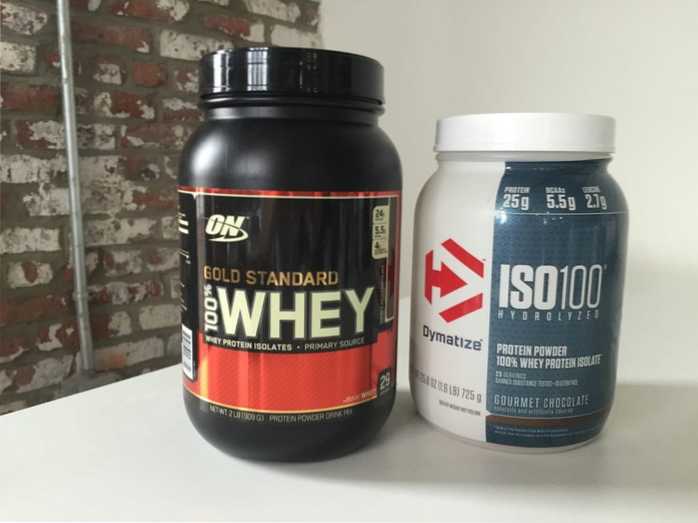
Price
Optimum Nutrition Gold Standard
Both tubs cost about the same, but they contain a different amount of product: there's two pounds in Gold Standard and 1.6 pounds in ISO 100.
Gold Standard is about $30 for 29 servings, so it's $1.03 per serving, or 4.3-ish cents per gram of protein.
Dymatize ISO 100
Roughly $30 for 1.6 pounds, or 24 servings. That comes to $1.25 per serving or 5 cents per gram of protein.
Winner: Optimum Nutrition Gold Standard
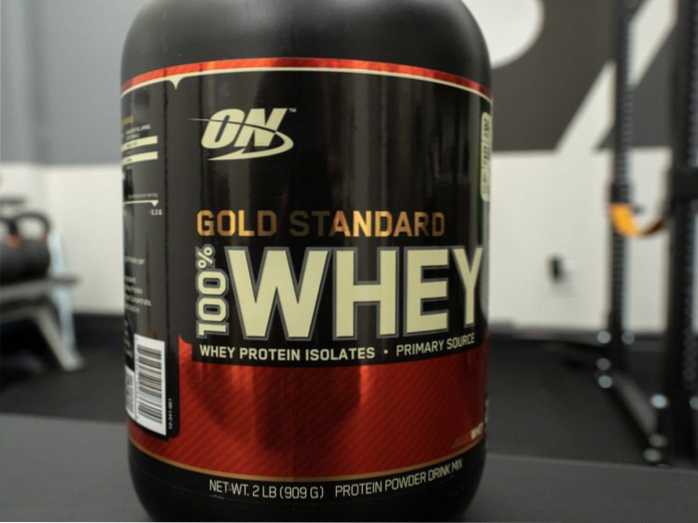
Taste
Optimum Nutrition Gold Standard
We're comparing Double Rich Chocolate to ISO 100's Gourmet Chocolate, and there are marked differences.
Double Rich Chocolate, despite the name, is relatively bland, and while it's perfectly pleasant when mixed with milk - that's adding cream and sugar, after all - it's underwhelming when mixed with water. A scoop in water tastes, more or less, like a spoonful of cocoa in water.
Dymatize ISO 100
ISO 100's Gourmet Chocolate, on the other hand, is sweeter and tastes much better with water and with milk. It's very rare for a protein powder to taste good with water, but if you handed me a pre-made shake of Dymatize, I'd believe that it had been mixed with milk.
If you're mixing with milk, they're both passable, with Gold Standard being a little more mellow. With water, there's no contest.
Winner: Dymatize ISO 100
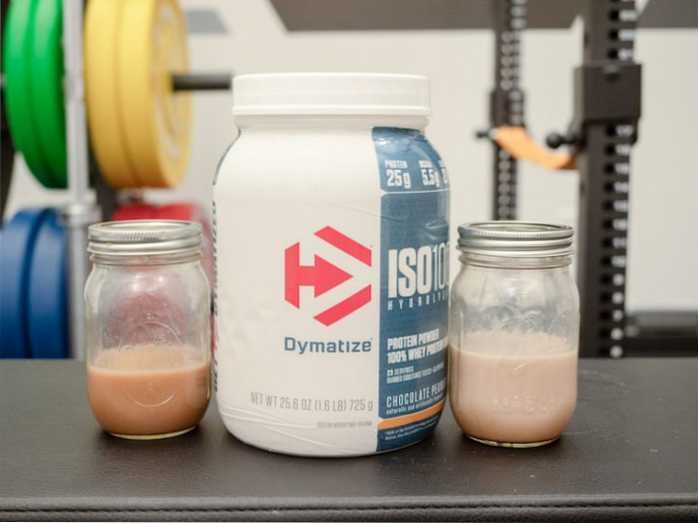
Overall Winner?
It's tough to pick between these two, and it really depends on what you value in a protein powder.
Optimum Nutrition has digestive enzymes, more flavors to choose from, and it's cheaper.
Dymatize tastes better with water, may absorb more quickly, it has a less controversial artificial sweetener, and due to the testing standards (and the potential benefits of hydrolyzed whey) it may be better suited for competitive athletes.
Personally, I always give the edge to whatever tastes good with water, which is Dymatize ISO 100. But if I were weighing which has the best ingredients, I'd probably give the edge to Optimum Nutrition because of the data supporting the use of digestive enzymes.
References
1. Potier M, et al. Comparison of digestibility and quality of intact proteins with their respective hydrolysates. J AOAC Int. 2008 Jul-Aug;91(4):1002-5.
2. Buckley JD, et al. Supplementation with a whey protein hydrolysate enhances recovery of muscle force-generating capacity following eccentric exercise. J Sci Med Sport. 2010 Jan;13(1):178-81.
3. Liang Y, et al. The effect of artificial sweetener on insulin secretion. 1. The effect of acesulfame K on insulin secretion in the rat (studies in vivo). Horm Metab Res. 1987 Jun;19(6):233-8.
4. Liang Y, et al. The effect of artificial sweetener on insulin secretion. II. Stimulation of insulin release from isolated rat islets by Acesulfame K (in vitro experiments). Horm Metab Res. 1987 Jul;19(7):285-9.
5. Cong WN, et al. Long-term artificial sweetener acesulfame potassium treatment alters neurometabolic functions in C57BL/6J mice. PLoS One. 2013 Aug 7;8(8):e70257.
6. Oben J, et al. An open label study to determine the effects of an oral proteolytic enzyme system on whey protein concentrate metabolism in healthy males. J Int Soc Sports Nutr. 2008 Jul 24;5:10.
7. Miller PC, et al. The effects of protease supplementation on skeletal muscle function and DOMS following downhill running. J Sports Sci. 2004 Apr;22(4):365-72.



Nimeni nu a comentat acest articol încă.